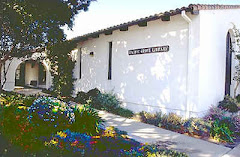 This month our exhibit cases feature historical photographs known as dageurreotypes, ambrotypes and tintypes.
This month our exhibit cases feature historical photographs known as dageurreotypes, ambrotypes and tintypes.The daguerreotype was the first successful, commercial, photographic process. Invented in 1839 by the French chemist, Louis J.M. Daguerre, the glittering mirror-like images elicited amazement, and caused a world-wide sensation. As reported in the American Journal "The Knickerbocker":
We have seen the views taken in Paris by the 'Daguerreotype,' and have no hesitation in avowing, that they are the most remarkable objects of curiosity and admiration, in the arts, that we ever beheld. Their exquisite perfection almost transcends the bounds of sober belief.
The quality of the photographs was stunning, in part due to the remarkable degree of detail. Carl Dauthendey, a 19th century professional photographer observed:
"People were afraid at first to look for any length of time at the pictures he produced. They were embarrassed by the clarity of these figures and believed that the little, tiny faces of the people in the pictures could see out at them, so amazing did the unaccustomed detail and the unaccustomed truth to nature of the first daguerreotypes appear to everyone."
Daguerreotypes and ambrotypes – and to a lesser extent tintypes – are fragile and highly susceptible to breakage, oxidation, and scratching. Very quickly, cases were designed to protect them. The earliest were made of pressed paper and leather; they featured a variety of geometric, floral, and patriotic motifs. Hundreds of different designs became available, with themes derived from nature, literature, history, and art.
made of pressed paper and leather; they featured a variety of geometric, floral, and patriotic motifs. Hundreds of different designs became available, with themes derived from nature, literature, history, and art.
The fragile photographs on display come from the collection of Esther Trosow.




No comments:
Post a Comment